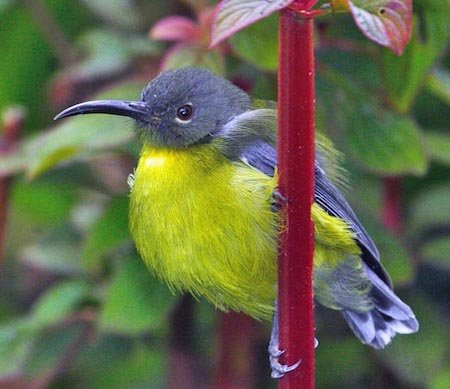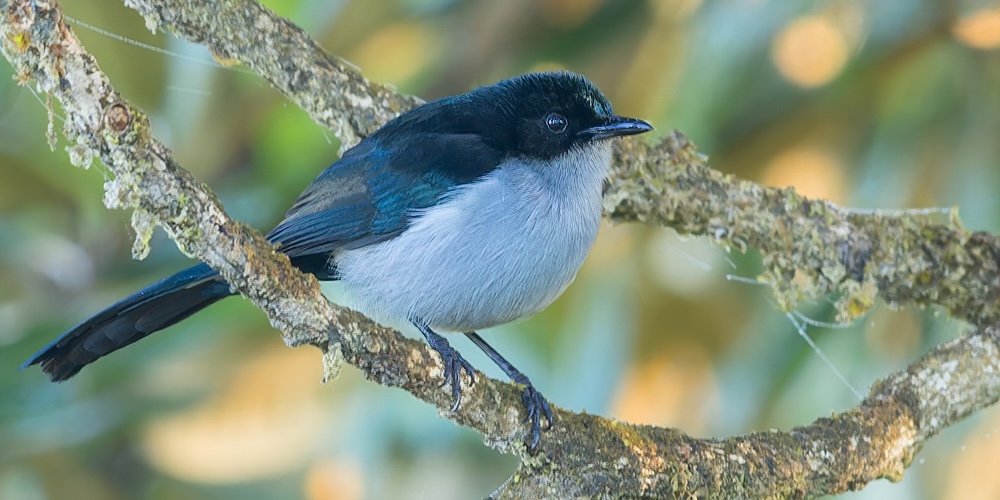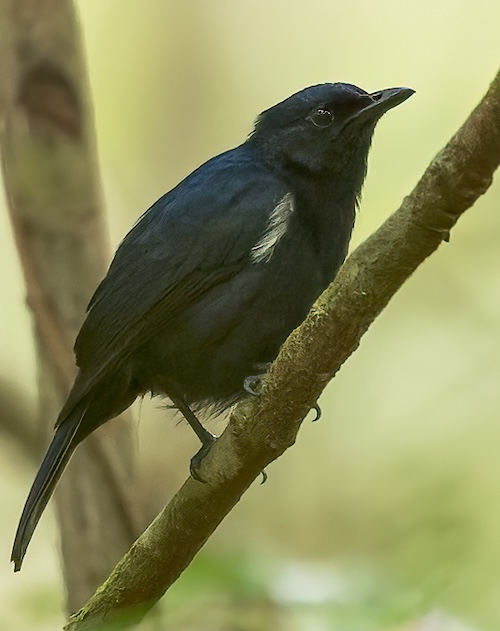Melanocharitidae – Berrypeckers & Longbills

The Melanocharitidae, the berrypeckers and longbills, are a small bird family restricted to the forests of New Guinea. The family contains ten species in four (sometimes three) genera. They are small songbirds with generally dull plumage but a range of body shapes.
The berrypeckers are generally montane species, with only one, the black berrypecker, being found in lowland forest. In contrast the longbills live in lowland forests and low montane forests as well as on small islands around New Guinea. Amongst the berrypeckers there is a succession of species at different altitudes, with the Black Berrypecker being found in the lowlands, the Mid-mountain Berrypecker being found at lower altitudes (mid-montane) and the fan-tailed berrypecker being found near the tree-line.

Fan-tailed Berrypecker Melanocharis versteri (Male) – ©Dubi Shapiro

Fan-tailed Berrypecker Melanocharis versteri (Female) – ©Dubi Shapiro
Melanocharitidae species are usually seen alone or in pairs. They may associate with mixed-species feeding flocks, but are loose members and not core species. The diet of the family is dominated by berries and small fruits. Arthropods are also gleaned from foliage, and more rarely by hovering and snatching. They are highly active feeders, seldom pausing except when at berries. Most species feed in the lower and middle levels of the forest, although records suggest that the Obscure Berrypecker will enter the canopy to forage.
 Black Berrypecker Melanocharis nigra – ©Dubi Shapiro
Black Berrypecker Melanocharis nigra – ©Dubi Shapiro
The male Black Berrypecker will also enter the canopy, while the female will remain lower down in the forest, suggesting some level of sexual segregation of feeding niches.
The breeding of some species is entirely undescribed, and little is known about the breeding in most species. Records of nests have been made in both wet and dry seasons. They build a cup nest, usually on a forked branch near the edge of a tree, out of fern scales and plant fibres bound neatly with insect or spider silk and ornamented with lichens. Little is known about the division of labour in the family, although the pattern exhibited by the Black Berrypecker, where the female constructs the nest alone but both sexes feed the young, may be typical of the family. They lay one or two eggs.

Obscure Berrypecker Melanocharis arfakiana – ©Dubi Shapiro
The berrypeckers and longbills are not considered to be threatened by human activities. No species is listed as threatened by the IUCN, although one species, the Obscure Berrypecker, is listed as data deficient. That species is known officially from two collected specimens, but unconfirmed reports suggest that it is not uncommon in remote parts of New Guinea.
-
Number of bird species: 12
(As at October 2025)
According to the recently (2025) amalgamated AviList, there are three genera, containing twelve species of Longbills and Berrypeckers in the Melanocharitidae family. They are:
Slaty-headed Longbill Toxorhamphus poliopterus
Yellow-bellied Longbill Toxorhamphus novaeguineae
Pygmy Longbill Oedistoma pygmaeum
Spectacled Longbill Oedistoma iliolophus
Obscure Berrypecker Melanocharis arfakiana
Black Berrypecker Melanocharis nigra
Mid-mountain Berrypecker Melanocharis longicauda
Fan-tailed Berrypecker Melanocharis versteri
Satin Berrypecker Melanocharis citreola
Streaked Berrypecker Melanocharis striativentris
Thick-billed Berrypecker Melanocharis crassirostris
Spotted Berrypecker Melanocharis piperata
-
Melanocharitidae
Family AccountBerrypeckers and longbills are generally dull or dark-plumaged birds that haunt the forests of New Guinea, eating insects supplemented by fruits or nectar. -
Melanocharitidae
Family AccountThe Melanocharitidae, the berrypeckers and longbills, is a small bird family restricted to the forests of New Guinea.
Given that this is a quite small family with just twelve species in only three genera, Fatbirder provides active links below to all species.
-
Black Berrypecker Melanocharis nigra
Species AccountA small, common bird of lowland and foothill forest. Fairly slender with a black bill. Male plumage varies geographically but all have black head, back, tail... -
Black Berrypecker Melanocharis nigra
Species AccountSound archive and distribution map -
Fan-tailed Berrypecker Melanocharis versteri
Species AccountThe fan-tailed berrypecker (Melanocharis versteri) is a species of bird in the family Melanocharitidae. It is found in New Guinea. -
Fan-tailed Berrypecker Melanocharis versteri
Species AccountSound archive and distribution map -
Mid-mountain Berrypecker Melanocharis longicauda
Species AccountThe mid-mountain berrypecker or lemon-breasted berrypecker (Melanocharis longicauda) is a species of bird in the family Melanocharitidae. -
Mid-mountain Berrypecker Melanocharis longicauda
Species AccountSound archive and distribution map -
Obscure Berrypecker Melanocharis arfakiana
Species AccountA small, rare and little-known bird of foothill forest. Medium gray head and back, pale gray throat and chest, and olive flight feathers. -
Obscure Berrypecker Melanocharis arfakiana
Species AccountSound archive and distribution map -
Pygmy Longbill Oedistoma pygmaeum
Species AccountA tiny bird of lowland and foothill forest canopy. Olive back, gray head and chest, pale belly and yellowish sides. -
Pygmy Longbill Oedistoma pygmaeum
Species AccountSound archive and distribution map -
Satin Berrypecker Melanocharis citreola
Species AccountThe satin berrypecker (Melanocharis citreola) is a species of berrypecker in the family Melanocharitidae that was described in 2021. -
Satin Berrypecker Melanocharis citreola
Species AccountSound archive and distribution map -
Slaty-headed Longbill Toxorhamphus poliopterus
Species AccountThe slaty-headed longbill or grey-winged longbill (Toxorhamphus poliopterus) is a species of bird in the Melanocharitidae family. It is found in New Guinea. Its natural habitats are subtropical or tropical moist lowland forests and subtropical or tropical moist montane forests. -
Slaty-headed Longbill Toxorhamphus poliopterus
Species AccountSound archive and distribution map -
Spectacled Longbill Oedistoma iliolophus
Species AccountThe spectacled longbill (Oedistoma iliolophus), also known as dwarf longbill, plumed longbill or dwarf honeyeater... -
Spectacled Longbill Oedistoma iliolophus
Species AccountSound archive and distribution map -
Spotted Berrypecker Melanocharis piperata
Species AccountA small, rare bird of mid-montane forest. Male is dark gray above and pale gray below with a slight, pale tuft on the side. -
Spotted Berrypecker Melanocharis piperata
Species AccountSound archive and distribution map -
Streaked Berrypecker Melanocharis striativentris
Species AccountA fairly small, rare bird of mid-montane forest interior. Mainly olive color with some streaking on the underparts, an indistinct, broad eye-ring and orange... -
Streaked Berrypecker Melanocharis striativentris
Species AccountThe streaked berrypecker (Melanocharis striativentris) is a species of bird in the family Melanocharitidae. It is found in the New Guinea Highlands. -
Thick-billed Berrypecker Melanocharis crassirostris
Species AccountA small, rare bird of mid-montane forest. Male is dark gray above and pale gray below with a slight, pale tuft on the side. -
Thick-billed Berrypecker Melanocharis crassirostris
Species AccountSound archive and distribution map -
Yellow-bellied Longbill Toxorhamphus novaeguineae
Species AccountA small, sunbirdlike bird of lowland and foothill forest. Long, thin, curved bill with olive upperparts and head. Southern birds have a brighter yellow belly. -
Yellow-bellied Longbill Toxorhamphus novaeguineae
Species AccountThe yellow-bellied longbill or green-crowned longbill (Toxorhamphus novaeguineae) is a species of bird in the family Melanocharitidae. -
Yellow-bellied Longbill Toxorhamphus novaeguineae
Species AccountSound archive and distribution map
